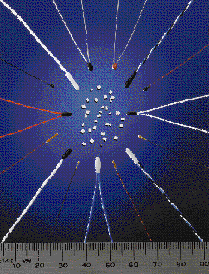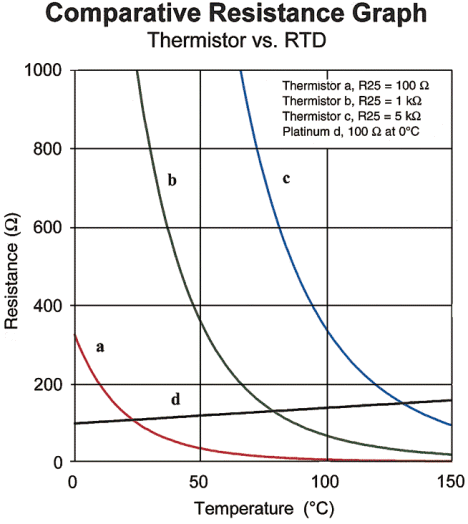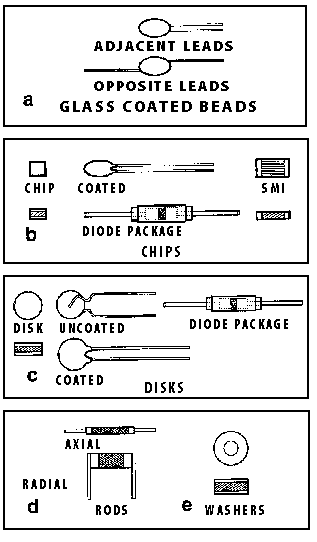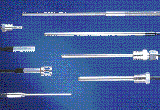After time, temperature is the variable most frequently measured. The three most common types of contact electronic temperature sensors in use today are thermocouples, resistance temperature detectors (RTDs), and thermistors. This article will examine the negative temperature coefficient (NTC) thermistor.
 |
Photo 1. NTC thermistors are manufactured in a variety of sizes and configurations. The chips in the center of the photo can be used as surface mount devices or attached to different types of insulated or uninsulated wire leads. The thermistor element is usually coated with a phenolic or epoxy material that provides protection from environmental conditions. For applications requiring sensing tip dimensions with part-to-part uniformity and/or smaller size, the devices can be encapsulated in PVC cups or polyimide tubes. |
General Properties and Features
Temperature Ranges and Resistance Values. NTC thermistors exhibit a decrease in electrical resistance with increasing temperature. Depending on the materials and methods of fabrication, they are generally used in the temperature range of -50°C to 150°C, and up to 300°C for some glass-encapsulated units. The resistance value of a thermistor is typically referenced at 25°C (abbreviated as R25). For most applications, the R25 values are between 100 Ω and 100 kΩ. Other R25 values as low as 10 Ω and as high as 40 MΩ can be produced, and resistance values at temperature points other than 25°C can be specified.
Accurate and Repeatable R/T Characteristic. The resistance vs. temperature (R/T) characteristic (also known as R/T curve) of the NTC thermistor forms the "scale" that allows its use as a temperature sensor. Although this characteristic is a nonlinear, negative exponential function, several interpolation equations are available that very accurately describe the R/T curve [1,2,3]. The most well known is the Steinhart-Hart equation: 1/T = A + B(lnR) + C(lnR)3
where: T = kelvin temperature R = resistance at temperature T
Coefficients A, B, and C are derived by calibrating at three temperature points and then solving the three simultaneous equations. The uncertainty associated with the use of the Steinhart-Hart equation is less than ±0.005°C for 50°C temperature spans within the 0°C-260°C range, so using the appropriate interpolation equation or lookup table in conjunction with a microprocessor can eliminate the potential nonlinearity problem.
Sensitivity to Changes in Temperature. The NTC thermistor's relatively large change in resistance vs. temperature, typically on the order of -3%/°C to -6%/°C, provides an order of magnitude greater sensitivity or signal response than other temperature sensors such as thermocouples and RTDs. On the other hand, the less sensitive thermocouples and RTDs are a good choice for applications requiring temperature spans >260°C and/or operating temperatures beyond the limits for thermistors.
 Figure 1. Over the range of -50°C to 150°C, NTC thermistors offer a distinct advantage in sensitivity to temperature changes compared to other temperature sensors. This graph illustrates the R/T characteristics of some typical NTC thermistors and a platinum RTD. |
Interchangeability. Another important feature of the NTC thermistor is the degree of interchangeability that can be offered at a relatively low cost, particularly for disc and chip devices. Interchangeability describes the degree of accuracy or tolerance to which a thermistor is specified and produced, and is normally expressed as a temperature tolerance over a temperature range. For example, disc and chip thermistors are commonly specified to tolerances of ±0.1°C and ±0.2°C over the temperature ranges of 0°C to 70°C and 0°C to 100°C. Interchangeability helps the systems manufacturer or thermistor user reduce labor costs by not having to calibrate each instrument/system with each thermistor during fabrication or while being used in the field. A health care professional, for instance, can use a thermistor temperature probe on one patient, discard it, and connect a new probe of the same specifications for use on another patient--without recalibration. The same holds true for other applications requiring reusable probes.
Small Size. The small dimensions of most bead, disc, and chip thermistors used for resistance thermometry make for a very rapid reponse to temperature changes. This feature is particularly useful for temperature monitoring and control systems requiring quick feedback.
Remote Temperature Sensing Capability. Thermistors are well suited for sensing temperature at remote locations via long, two-wire cable because the resistance of the long wires is insignificant compared to the relatively high resistance of the thermistor.
Ruggedness, Stability, and Reliability. As a result of improvements in technology, NTC bead, disc, and chip thermistor configurations are typically more rugged and better able to handle mechanical and thermal shock and vibration than other temperature sensors.
Materials and Configurations
Most NTC thermistors are made from various compositions of the metal oxides of manganese, nickel, cobalt, copper, and/or iron. A thermistor's R/T characteristic and R25 value are determined by the particular formulation of oxides. Over the past 10 years, better raw materials and advances in ceramics processing technology have contributed to overall improvements in the reliability, interchangeability, and cost-effectiveness of thermistors.
Of the thermistors shown in Figure 2, beads, discs, and chips are the most widely used for precise temperature measurements. Although each configuration is produced by a unique method, some general ceramics processing techniques apply to most thermistors: formulation and preparation of the metal oxide powders; milling and blending with a binder; forming into a "green" body; heat-treating to produce a ceramic material; addition of electrical contacts (for discs and chips); and, for discrete components, assembly into a usable device with wire leads and a protective coating.
 Figure 2. A variety of manufacturing processes are used to make NTC thermistors configured as beads (A), chips (B), discs (C), rods (D), and washers (E). |
| Historical Note on the Thermistor Michael Faraday (1791-1867), the British chemist and physicist, is best known for his work in electromagnetic induction and electrochemistry. Less familiar is his 1833 report on the semiconducting behavior of Ag2S (silver sulfide), which can be considered the first recorded NTC thermistor [9]. Because the early thermistors were difficult to produce and applications for the technology were limited, commercial manufacture and use of thermistors did not begin until 100 years later. During the early 1940s, Bell Telephone Laboratories developed techniques to improve the consistency and repeatability of the manufacturing process [10]. Some of the first commercial thermistors were the disc type, and by today's standards, their tolerances were quite broad. These devices were used primarily for regulation, protection, and temperature compensation of electronic circuits. In the 1950s and 1960s, the expanding aerospace industry's requirement for more accurate and stable devices led to several improvements in the materials used to manufacture glass bead and disc thermistors. During the 1960s and 1970s, the demand for tight-tolerance devices in high volumes at a lower cost led to the development of the chip thermistor [11]. As the reliability of these devices improved during the 1980s, the use of electronic thermometers in the health care industry increased. The rising costs of sterilization and concerns about cross-infection among patients led to the demand for low-cost disposable temperature probes, for which chip thermistors were well suited. Throughout the 1980s and 1990s, the use of NTC thermistors has continued to grow in the automotive, food processing, medical, HVAC, and telecommunications markets. |
Bead thermistors, which have lead wires that are embedded in the ceramic material, are made by combining the metal oxide powders with a suitable binder to form a slurry. A small amount of slurry is applied to a pair of platinum alloy wires held parallel in a fixture. Several beads can be spaced evenly along the wires, depending on wire length. After the beads have been dried, the strand is fired in a furnace at 1100°C-1400°C to initiate sintering. During sintering, the ceramic body becomes denser as the metal oxide particles bond together and shrink down around the platimum alloy leads to form an intimate physical and electrical bond. After sintering, the wires are cut to create individual devices. A glass coating is applied to provide strain relief to the lead-ceramic interface and to give the device a protective hermetic seal for long-term stability. Typical glass bead thermistors range from 0.01 in. to 0.06 in. (0.25 mm to 1.5 mm) in dia.
Disc thermistors are made by preparing the various metal oxide powders, blending them with a suitable binder, and then compressing small amounts of the mixture in a die under several tons of pressure. The discs are then fired at high temperatures to form solid ceramic bodies. A thick film electrode material, typically silver, is applied to the opposite sides of the disc to provide the contacts for the attachment of lead wires. A coating of epoxy, phenolic, or glass is applied to each device to provide protection from mechanical and environmental stresses. Typical uncoated disc sizes range from 0.05 in. to 0.10 in. (1.3 mm to 2.5 mm) in dia.; coated disc thermistors generally measure 0.10 in. to 0.15 in. (2.5 mm to 3.8 mm) in dia.
Chip thermistors are manufactured by tape casting, a more recent technique borrowed from the ceramic chip capacitor and ceramic substrate industries. An oxide-binder slurry similar to that used in making bead thermistors is poured into a fixture that allows a very tightly controlled thickness of material to be cast onto a belt or movable carrier. The cast material is allowed to dry into a flexible ceramic tape, which is cut into smaller sections and sintered at high temperatures into wafers 0.01 in. to 0.03 in. (0.25 mm to 0.80 mm) thick. After a thick film electrode material is applied, the wafers are diced into chips. The chips can be used as surface mount devices or made into discrete units by attaching leads and applying a protective coating of epoxy, phenolic, or glass. Typical chip sizes range from 0.04 in. by 0.04 in. (1 mm by 1 mm) to 0.10 in. by 0.10 in. (2.5 mm by 2.5 mm) in square or rectangular shapes. Coated chip thermistors commonly measure from 0.08 in. to 0.10 in. (2.0 mm to 2.5 mm) in diameter. Very small coated chip thermistors 0.02 in. to 0.06 in. (0.5 mm to 1.5 mm) in dia. are available for applications requiring small size, fast response, tight tolerance, and interchangeability.
Washer-shaped thermistors are essentially a variation of the disc type except for having a hole in the middle, and are usually leadless for use as surface mount devices or as part of an assembly. Rod-shaped thermistors are made by extruding a viscous oxide-binder mixture through a die, heat-treating it to form a ceramic material, applying electrodes, and attaching leads. Rod thermistors are used primarily for applications requiring very high resistance and/or high power dissipation.
 |
Photo 2. NTC thermistors can be attached to extension leads or jacketed cable and assembled into various types of housings. The optimum materials, dimensions, and configuration for a probe assembly are determined by careful review of the application requirements. |
Comparison of Thermistor Configurations
One of the problems the thermistor industry has faced over the years is that some manufacturers have claimed their particular style or configuration of thermistor is better than other configurations made by their competitors, without regard to other, more pertinent factors. These thermistor "politics," more harmful than beneficial to the industry, can confuse engineers and purchasing agents who are looking for reliable information to help them choose the appropriate product for their application. Although some thermistor qualities or capabilities, including interchangeability, repeatability, size, responsiveness, and stability, can either be enhanced or limited by style or geometry, these characteristics are much more dependent on a manufacturer's ability to understand the ceramics technology being used and to maintain control of the manufacturing process.
Glass-coated beads feature excellent long-term stability and reliability for operation at temperatures up to 300°C. Studies at the National Institute of Standards and Technology (NIST) and other laboratories indicate that some special bead-in-glass probes have measurement uncertainties and stabilities (better than ± 0.003°C for temperatures between 0°C and 100°C) that approach those of some standard platinum resistance thermometers [3,4,5]. The relatively small size of glass bead thermistors gives them a quick response to temperature changes, but for some applications this small size can make the devices hard to handle during assembly and have the effect of limiting their power dissipation. It is also more difficult and more expensive to produce glass beads with close tolerances and interchangeability. Individual calibration and R/T characterization, resistor network padding, or use of matched pairs are among the methods used to achieve interchangeability.
Chip and disc thermistors are noted for their tight tolerances and interchangeability at a relatively low cost compared to bead thermistors. These qualities are inherent in the manufacturing processes. The thermistors' larger size permits power dissipation higher than that of beads, although at some expense of response times. Larger size can be a disadvantage in some applications. Because of their geometry, disc thermistors normally have larger coated diameters and higher power dissipation capabilities than chip thermistors. On the other hand, chip thermistors typically can be produced to smaller coated diameters and are better suited for applications requiring smaller size and faster response times. More recent designs of chip thermistors allow the production of sizes and response times approaching those of glass beads. In some cases, chip and disc thermistors with equivalent physical and electrical characteristics can be used in the same applications without any noticeable difference in performance.
Thermistors, thermocouples, RTDs, and other sensors and electronic components exhibit a phenomenon called drift, a gradual, predictable change in certain properties over time. For a thermistor, drift results in a change in resistance from its initial value, typically after being continuously exposed to or cycled to an elevated temperature. Thermistor drift is expressed as a percent change in resistance and/or as a change in temperature that occurs at a given exposure temperature for a certain length of time. As the exposure temperature increases, so do the drift and the drift rate [4,5,6].
Chip and disc thermistors with soldered leads and an epoxy or phenolic coating have potential limitations in their maximum operating temperatures, typically 150° C for short-term exposures (1-24 hours) and 105°C for long-term exposures (1-12 months). When subjected to environmental conditions above their recommended maximum operating temperatures, epoxy- or phenolic-coated chips and discs can begin to exhibit an undesirable, excessive amount of drift. When such thermistors are used at temperatures below the specified maximum operating temperatures, drift is minimal, on the order of 0.02°C to 0.15°C after 12 months of continuous exposure to temperatures between 25°C and 100°C, respectively. Recent advances in the techniques used to manufacture chip and disc thermistors with a glass coating have produced devices that combine the interchangeability advantage of chips and discs with the stability of glass beads [5,6]. For applications that require operating temperatures up to 200°C, these new devices offer a lower cost alternative to the conventional glass bead thermistors.
These comparisons can help determine whether a thermistor supplier is objectively evaluating an application in terms of the appropriate thermistor, or simply promoting the configuration it manufactures. For an example of the latter approach, see [7], where a manufacturer of disc thermistors stated that "Loose-tolerance thermistors are usually mass-produced by tape casting," and that "These devices . . . are designed for applications requiring neither interchangeability nor a high degree of accuracy," implying that all chip thermistors are loose tolerance. On the contrary, millions of precision chip thermistors with superior long-term stability are produced annually to an interchangeable tolerance of ±0.1°C, and they are available with an interchangeability of ±0.05°C. In reality, broad-tolerance and tight-tolerance thermistors are available in each of the three major thermistor configurations discussed above.
After determining the appropriate specifications, the engineer and purchasing agent need to evaluate which configuration and supplier will best meet the requirements for process control, quality, on-time delivery, and value at a reasonable price. An important part of the evaluation process is to perform some basic tests on the design and quality of the thermistor and, wherever possible, include simulation of the actual environmental conditions of the intended application. To achieve optimum performance, thermistors are usually mounted into protective housings or probe assemblies (see Photo 2). For additional information on sensor assembly design, see [8]. An informed decision can then be made as to which product and supplier will provide the best value for the application requirement. Part II of this article will examine the ways to perform these tests.
References
1. J.S. Steinhart and S.R. Hart. 1968. "Calibration Curves for Thermistors," Deep Sea Research 15:497.
2. M. Sapoff et al. 1982. "The Exactness of Fit of Resistance-Temperature Data of Thermistors with Third-Degree Polynomials," Temperature, Its Measurement and Control in Science and Industry, Vol. 5, James F. Schooley, ed., American Institute of Physics, New York, NY:875.
3. W.R. Siwek et al. 1992. "A Precision Temperature Standard Based on the Exactness of Fit of Thermistor Resistance-Temperature Data Using Third Degree Polynomials," Temperature, Its Measurement and Control in Science and Industry, Vol. 6, James F. Schooley, ed., American Institute of Physics, New York, NY:491.
4. S.D. Wood et al. 1978. "An Investigation of the Stability of Thermistors," J Res of the Nat Bur of Stds:83, 247.
5. W.R. Siwek et al. 1992. "Stability of NTC Thermistors," Temperature, Its Measurements and Control in Science and Industry, Vol. 6, James F. Schooley, ed., American Institute of Physics, New York, NY:497.
6. J.A. Wise. 1992. "Stability of Glass-Encapsulated Disc-Type Thermistors," Temperature, Its Measurement and Control in Science and Industry, Vol. 6, James F. Schooley, ed., American Institute of Physics, New York, NY:481.
7. C. Faller and F. Arment. Jun. 1996. "NTC Thermistor Update," Sensors:22.
8. D. McGillicuddy. Dec. 1993. "NTC Thermistor Basics and Principles of Operation," Sensors:42.
9. D. Hill and H. Tuller. 1991. "Ceramic Sensors: Theory and Practice," Ceramic Materials for Electronics, R. Buchanan, ed., Marcel Dekker, Inc., New York, NY:272.
10. U.S. Patent No. 2,258,646, 14 Oct. 1941.
11. R.L. Winter, former chairman and CEO, Western Thermistor Corp., private communication. Jul. 1996.
